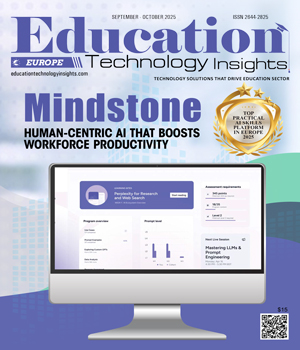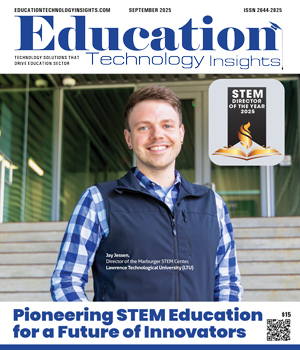THANK YOU FOR SUBSCRIBING
Be first to read the latest tech news, Industry Leader's Insights, and CIO interviews of medium and large enterprises exclusively from Education Technology Insights
The Role of Technology in College Admissions, Recruitment, and Enrollment
Shreail Hinton, M.Ed, Director of Admissions at Nash Community College
 Shreail Hinton, M.Ed, Director of Admissions at Nash Community College
Shreail Hinton, M.Ed, Director of Admissions at Nash Community CollegeThe landscape of higher education has evolved significantly in the digital age, with technology playing an increasingly pivotal role in shaping college admissions, recruitment and enrollment. Institutions across the globe are leveraging digital tools, artificial intelligence (AI), big data analytics and virtual platforms to streamline processes, enhance accessibility and improve student engagement. These advancements have not only made the admissions process more efficient but have also expanded opportunities for prospective students. This article explores how technology is transforming these aspects of higher education and the implications for students and institutions alike.
Technology in College Admissions
College admissions have traditionally been a complex and time-consuming process for both students and institutions. However, the integration of technology has introduced efficiency and transparency into the system.
● Automated Application Processing
Many universities now use AI-powered platforms to automate application review processes. Machine learning algorithms assist in sorting applications, identifying qualified candidates and even detecting fraudulent submissions. These tools help admissions officers manage large volumes of applications, allowing them to focus on qualitative aspects such as personal essays and recommendation letters.
● Digital Credential Verification
Blockchain technology has transformed credential verification, reducing the risk of academic fraud. Institutions such as MIT have implemented blockchain-based diplomas, allowing students to share verified academic records securely with colleges and employers. This not only expedites the admissions process but also enhances trust in student qualifications.
● AI-Driven Admissions Decisions
Some colleges have begun to experiment with AI-assisted decision-making tools to assess applicants. These tools analyze past admissions data to predict student success and retention rates, helping institutions make more informed decisions. On the other hand, ethical concerns regarding bias and transparency continue to be debated.
Technology in Student Recruitment
Recruiting students has become more competitive, pushing colleges to adopt innovative digital marketing strategies and data-driven approaches to attract prospective applicants.
● Social Media and Digital Marketing
Institutions increasingly rely on social media platforms such as Instagram, TikTok and LinkedIn to connect with prospective students. These platforms allow universities to showcase campus life, highlight academic programs and engage with students in real-time. Paid advertisements and influencer partnerships further enhance outreach efforts, targeting specific demographics based on interests and browsing behavior.
● Virtual Tours and Augmented Reality (AR)
The days when campus visits were the only way for students to explore colleges are gone. Virtual tours and AR experiences now allow prospective students to explore campuses from anywhere in the world. Colleges such as Stanford and Harvard offer 360-degree virtual tours, providing an immersive experience that helps students make informed decisions without the need for travel.
● Predictive Analytics for Targeted Outreach
Big data analytics enables institutions to identify and engage with potential applicants more strategically. Predictive analytics tools assess student demographics, academic performance and online behavior to personalize recruitment efforts. By analyzing data patterns, universities can send tailored communication and financial aid offers to students who are most likely to enroll.
Technology in Enrollment Management
Once students are admitted, technology continues to play a crucial role in managing and improving the enrollment process, ensuring a seamless transition into college life.
"Technology continues to redefine the landscape of college admissions, recruitment, and enrollment, offering innovative solutions to longstanding challenges."
● Chatbots and AI Assistants
Many universities have implemented AI-driven chatbots to assist students with inquiries related to enrollment, financial aid and course registration. These chatbots provide 24/7 support, reducing the workload on administrative staff and enhancing student satisfaction.
● Customer Relationship Management (CRM) Systems
Higher education institutions use CRM systems to track student interactions from initial inquiry to enrollment. Platforms such as Salesforce Education Cloud allow universities to automate follow-ups, send reminders about deadlines and provide personalized assistance. This ensures that prospective students remain engaged throughout the decision-making process.
● Mobile Enrollment Applications
To cater to tech-savvy students, colleges have developed mobile apps that allow applicants to track their admission status, submit documents and complete enrollment processes seamlessly. These applications improve accessibility and streamline administrative tasks for both students and institutions.
Challenges and Ethical Considerations
While technology has significantly improved efficiency and accessibility in college admissions, recruitment and enrollment, challenges and ethical concerns persist.
● Data Privacy and Security
With the increased reliance on digital platforms, institutions must ensure the protection of student data. Cybersecurity threats, data breaches and concerns over third-party data sharing necessitate stringent data protection policies. Compliance with regulations such as the Family Educational Rights and Privacy Act (FERPA) is crucial.
● Algorithmic Bias in AI Admissions
AI-driven admissions tools raise concerns about algorithmic bias. If trained on biased historical data, AI models may perpetuate inequalities in the selection process. Ensuring transparency and fairness in AI decision-making remains a priority for institutions.
● Digital Divide and Accessibility Issues
Not all students have equal access to technology, particularly those from low-income backgrounds or rural areas. Universities must consider strategies to bridge the digital divide by providing alternative access to application processes, recruitment materials and enrollment resources.
Conclusion
Technology continues to redefine the landscape of college admissions, recruitment, and enrollment, offering innovative solutions to longstanding challenges. From AI-driven application processing and predictive analytics in recruitment to chatbot-assisted enrollment, digital advancements have made higher education more accessible and efficient. That said, ethical considerations, data security concerns and the digital divide must be addressed to ensure equitable access for all students. As technology evolves, institutions must strike a balance between innovation and inclusivity to create a fair and transparent admissions ecosystem.
Read Also
Designing Learning that Transforms and Fosters Change
Stop Chasing Interesting. Start Choosing Impact.
Leading with Purpose to Strengthen Campus Belonging
Achieving Educational Excellence through Meaningful Engagements
Beyond Administration: How a School Management System Transforms Learning Communities
Empowering Educators through Purposeful, Connected and Transformative Learning

I agree We use cookies on this website to enhance your user experience. By clicking any link on this page you are giving your consent for us to set cookies. More info

However, if you would like to share the information in this article, you may use the link below:
www.educationtechnologyinsightseurope.com/cxoinsights/shreail-hinton-nid-3103.html




















